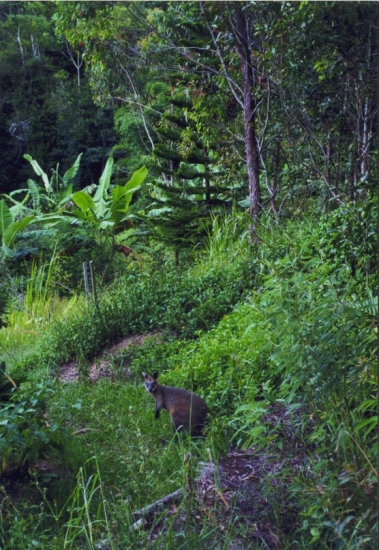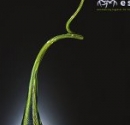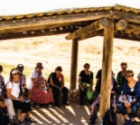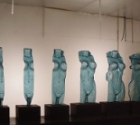
One of the rain forest inhabitants, the wallaby, is a smaller version of the kangaroo
A sort of introduction
Quite a while back on this planet (so I read) there was a landmass known as Pangaea. This mass began to break up into various continents about three hundred million years ago (well, okay – add or subtract: see if I care).
One of the landmasses, I read further, carried away all sorts of strange creatures as it floated free of its neighbors. Today the place is called Australia, and the strange creatures are still there, most of them living in the rain-forests. I’m sorry to say, we didn’t see them. But we did hear them.
We are in Queensland – south-eastern Queensland, to be exact. We find out that the rain forest we are staying in is only a sub-tropical forest – much more manageable than the older members of its family which are found about 800 kilometers further north. Here it is that the true tropical rain forests exist: the sun cannot penetrate the dense foliage, there is a perpetual smell of rotting leaves, and the pythons grow to six meters or more in length.
Well all right. We’re here, and we’ve just got to be satisfied with the smaller pythons; and so here we stay for the next three weeks.
We are told that the really dangerous things in the forest don’t make noise – it’s the people who must. As you walk, so my son (who is a resident here) instructs me, you stamp and make as much noise as you can. This way you let the snake in the grass know something big is coming and he’d better get going while the going’s good.
So that first night, as I progress along small dark trails between huts, trees, ferns and bamboo, and through luxuriant long grass on this mountain ledge, I stamp, whistle, clap my hands and generally move like the dancing gumboot “boys” of the Johannesburg gold mines. Eyal is right: they don’t bother me at all – although a leech did manage to spoil my new sandals before I caught him at it.
But.I am bothered by all manner of night noises
That first night I wake up in pitch darkness – and hear it again. Someone is slowly walking across the wooden floor a slow and heavy, clumping sound. The light switch is far away and, I have been told, nobody locks doors around here. Once more I realize – as if I didn’t know it before – what an uncontrollable world the imagination is.
Next morning I am told that it must have been a possum (phalanger) foraging for food. They do this at night. They’re gentle creatures, Eyal assures me, and very shy. So shy, in fact, we never manage to see one.
Neither did we see the koalas, whip birds and kookaburras – although they were all around us.
We did hear them – most of them. In fact the prize for the noisiest creatures of the rain forest must surely belong to the birds.
Every morning, shortly before the sun comes up, we are woken up by the chorus of kookaburras (a sort of kingfisher, very friendly and very cheeky – unless one is a snake, which this bird eats).
Picture a dozen or so old geezers at a pub, all laughing crazily at some communal joke, and you’re pretty close to what I was hearing. Eventually the collective ha ha’s melt away, except for one geezer gasping “oh-oh-oh” till the tears come to his eyes, and it really sounds like someone has to bang him on the back so he can get his breath back. Then complete and utter silence for about half a minute, and suddenly they all recollect the joke and the whole lot get going again.
After their “pub” round, the group fades off home (except for the odd bird here and there) and the whip birds get going.
One bird starts off the chorus of neighbourhood whippers with a long, low whistle which sounds like a bomb coming in on target. The whistle ends with a crash – like a whip hitting the ground. The noise is a shock in the quietness of the morning. After a while another bird replies. They keep this up at odd intervals for the rest of the day.
A more cheerful note is sounded by the “frogs’ chorus” (there are rainwater pools in the valley just below us). For ease of recognition I call the two groups of singers the castratos and the ping-pong frogs.
The noise the castrato chorus makes sounds like the shrill of hundreds of parked cars with their alarms all going off. I would guess that these sounds are made by very small frogs.
Another group of frogs – the ping-pong frogs – gives voice more often in the spells between the flurries of rain. I imagine the ping-pong frog as being a singer of a larger, graver variety. The sound he makes is a very deliberate “pock”, something like the sound a ping-pong ball makes when you hit it with a bat. Another frog joins in with his “pock” and, slowly, others join in until the whole valley sounds like a table tennis tournament in the Royal Albert Hall with scores of dignified frogs pocking away at each other.
One night there is a harsh noise, something like a sheet of corrugated iron being dragged over concrete. Probably an owl. Hearing it makes “one” think of ghosts and monsters. (I’m glad to say I only heard it that one time.)
In this area (Noosa Heads) the farmers are being paid not to farm, but to let rain forests grow once more (like the reclaimed forest we are staying in). But there are many gently sloping mountain tops around us where the forests were once destroyed to provide pasture land for cattle to graze. Cattle don’t usually bother me, but I came across this one exception.
In the late hours of the night the mooing from the valley below us begins: a cow has wandered too far away and is letting all of us know how she feels. With remarkable persistence this cow got lost almost every night.
At long last here is a noise I can identify, but why oh why does it have to be at two o’clock in the morning.
 LEV-RAN SCHOOL: A LOVE STORY (new)
LEV-RAN SCHOOL: A LOVE STORY (new) DEAR EDITOR 154
DEAR EDITOR 154 KNITTING CLUBS: TEL AVIV'S KNITTING & CROCHET SOCIAL CIRCLE
KNITTING CLUBS: TEL AVIV'S KNITTING & CROCHET SOCIAL CIRCLE From Bible to Bedouins and Battles
From Bible to Bedouins and Battles Trip to the Dead Sea
Trip to the Dead Sea Japan
Japan Mike Porter
Mike Porter